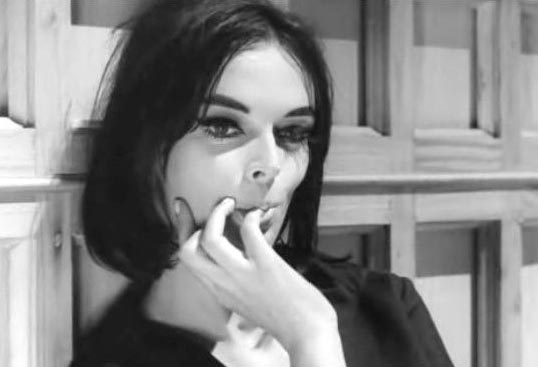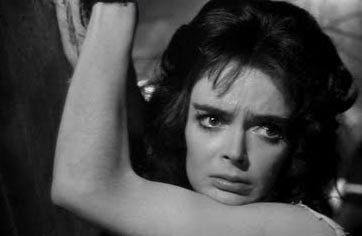Craig here with this week's Take Three: Barbara Steele
 Barbara Steele in Federico Fellini's immortal 8 ½
Barbara Steele in Federico Fellini's immortal 8 ½
Take One: Black Sunday (1960)
In Mario Bava’s Black Sunday (also known as La maschera del demonio or The Mask of Satan) Steele plays Princess Asa Vajda, a woman put to death by her brother in Moldavia, 1630 only to be resurrected 200 years later as a vampire-witch. Steele also has a second, key role, as local woman Katia Vajda. Princess Asa’s eager to wreak the long-promised revenge upon her descendants – thus proving Sunday is far from a day of rest for the undead. Black Sunday, highly influential and memorable to future horror like Bloody Pit of Horror, Bram Stoker’s Dracula and Sleepy Hollow, features some of Steele’s best work.
 That's particularly true in the film's gory opening prologue where she meets her first death. Many horror fans recall with wicked grins this moment that most likely lead to Steele favouring the horror genre throughout much of the ‘60s. (See also 1965’s Nightmare Castle where she also played dual roles and 1966’s The She Beast, where she’s memorably possessed by the titular lady-ogre.) She conveys an immense sense of terror with impeccable assurance. More crucially, she does so with formidable levels of hysteria apt for a future grande dame of horror cinema. Her cries resound in the prologue like guttural shrieks from beyond the grave, but she manages to rattle off a thrilling, yet oddly wordy, pre-death warning to her condemners
That's particularly true in the film's gory opening prologue where she meets her first death. Many horror fans recall with wicked grins this moment that most likely lead to Steele favouring the horror genre throughout much of the ‘60s. (See also 1965’s Nightmare Castle where she also played dual roles and 1966’s The She Beast, where she’s memorably possessed by the titular lady-ogre.) She conveys an immense sense of terror with impeccable assurance. More crucially, she does so with formidable levels of hysteria apt for a future grande dame of horror cinema. Her cries resound in the prologue like guttural shrieks from beyond the grave, but she manages to rattle off a thrilling, yet oddly wordy, pre-death warning to her condemners
My revenge will strike down you and your accursed house!”
[Two more takes, one of them Cronenbergian, after the jump...]
Steele didn’t earn her nickname ‘The Queen of All Scream Queens’ for sitting idly back as a silent witness. Her dark and famously striking eyes contain an almost unearthly amount of fear, especially when she’s having her face nailed into ‘The Mask of Satan’. And the moment when, resurrected from the grave, she eerily turns to camera with a horrific expression fixed upon on her hole-riddled face, will surely be etched into viewer’s minds forever. There were very few ‘60s genre actresses who could match or surpass even a few minutes of Steele’s twisted elegance in Black Sunday.
Take Two: Curse of the Crimson Altar (1968)
Babs got to practice a ‘Blue Steele’ look in Curse of the Crimson Altar, aka The Crimson Cult, a ‘spooky mansion’ horror from Tigon Films. (Tigon Films was a similar but smaller horror production company to Hammer and Amicus.) Steele opens the film in splendidly batty fashion sporting feathered ram’s horns, bright red lipstick, what appear to be ostentatiously puffy chainmail sleeves and... blue skin; she strikes a ludicrous figure. Good thing really, considering she’s playing High Priestess of Craxted Lodge, Lavinia Morley, an ancient witch burned at the stake eons ago who now seeks revenge on her descendants (yes, again – Steele's clearly very keen on doing this). She wants us to “enter a world of darkness,” and indeed poor leading man Mark Eden does just that. Steele’s role here requires more than to just look ridiculously brilliant or brilliantly ridiculous. She’s the mythological evil in the attic, cautiously recalled by everyone concerned with the house.
However, the actress mainly just pops up in lurid, green-hued dream sequences – the kind that David Lynch might’ve given his right ear to direct – with a dagger and a frosty look in her eyes. She comes across like a Valley of the Dolls extra on prescription downers, and she mostly just provides her victims with a blood-tipped quill and a sheet of A4 and shouts “Sign!... SIGN!” at them so she can check them off her death list. But she’s remarkably good at dishing orders in ripe, theatrical fashion, especially as she reserves a derisory glance for everyone who meets her sightline and has a way of crossing a room that suggests she’s on hidden castors. She crops up in the last scene atop the flaming mansion, laughing her tits off at the cowering commoners below. She knows how enter and exit a movie with style. It really was all queens and curses with Steele.
 Take Three: Shivers (1977)
Take Three: Shivers (1977)
The terror came from within for Steele as "Betts" in the form of aphrodisiac and venereal disease generated sex parasites. How lovely. But all in a day’s work, especially for director David Cronenberg at the time.
Betts, the most seductively hippy-ish resident of Starliner Towers (Shivers’ clinically imposing apartment block setting) runs what might be the most sinister bath in the history of cinema thanks to Cronenberg’s suitably ominous direction. Then things get even creepier: submerged in the tub, glass of wine in hand (Betts is never without a bottle of rosé), She gets, shall we say, invaded by a turd-like plughole parasite, thus royally ruining her relaxing soak. But Betts appeared to have a pronounced sexual appetite before playing host to any ‘sex slugs’. Steele uses her years of well-tested screen comeliness and stunning cheekbone structure with indubitable ease when batting her lashes at neighbour Susan Petrie early on, thus positioning herself to represent the fluid sexuality bubbling under the film’s surface.
Her role is indeed a small one, but she’s a perfect Cronenbergian figurehead, and crucial to the secretive, hothouse atmosphere of a film with such a frosty sounding title. The dangerously alluring look she gives poor, ill-fated cop Paul Hampton, as she’s beckoning him into the building’s pool, is saucily reminiscent of so many ‘Steeley’ looks over the years. She always gives good face.

Three more films for the taking: The Terror of Dr. Hichcock (1962), Castle of Blood (1964), Piranha (1978)
